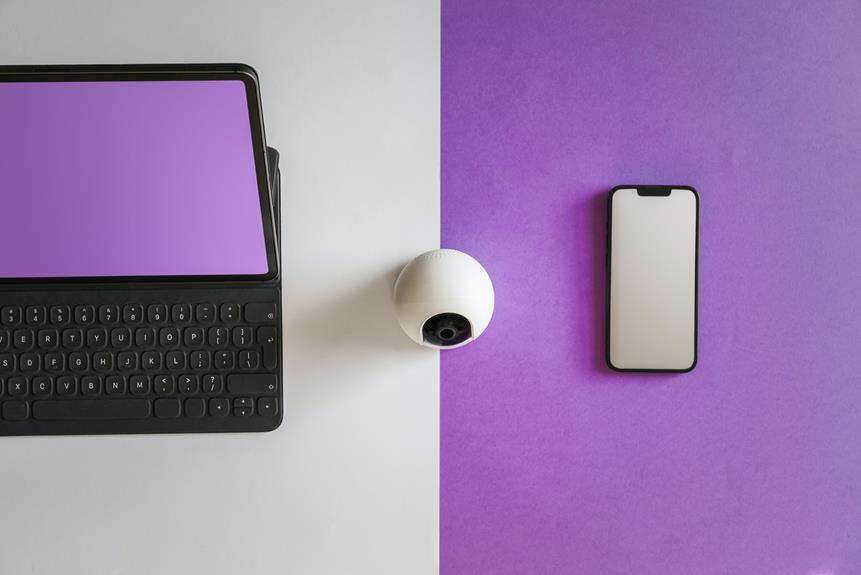Looking for a remote access app that seamlessly integrates with your home office setup? With the plethora of options available, it can be overwhelming to navigate through the sea of features and functionalities. But fear not, because we're here to help you make an informed decision that suits your specific needs.
From compatibility and device support to security features and encryption, there are key factors to consider when choosing the best remote access app for your home office.
So, which app will rise to the top as the ultimate solution for your remote work needs?
Key Takeaways
- Compatibility with various devices and operating systems is crucial for a remote access app.
- Security and privacy features, such as robust encryption and multi-factor authentication, should be prioritized.
- User-friendly interface and ease of use are important for enhancing productivity.
- Performance and connection stability, including smooth functionality and fast data transfer rates, are essential for a seamless remote access experience.
Compatibility and Device Support
Ensure that the remote access app is compatible with all your devices, including smartphones, tablets, and computers, to maximize productivity and efficiency while working from your home office. Device compatibility is essential for seamless access to your work resources. When evaluating remote access apps, consider the operating systems of your devices.
The app should support popular operating systems such as Windows, macOS, iOS, and Android. This ensures that whether you're using a Windows laptop, a Mac desktop, an iPhone, or an Android tablet, you can access your work resources without any compatibility issues.
When the remote access app is compatible with all your devices, it allows you the flexibility to switch between them based on your needs and preferences. For instance, you might start working on a project on your computer in your home office, then continue working on it using your tablet while relaxing in the backyard. This seamless transition between devices is only possible when the app is compatible with the operating systems running on your devices.
Moreover, having a remote access app that supports multiple operating systems future-proofs your setup. If you decide to switch from one type of device to another in the future, you won't have to worry about finding a new remote access solution.
Therefore, ensuring device compatibility and support for various operating systems is crucial when choosing a remote access app for your home office.
Security Features and Encryption
To enhance the security of your remote access, consider the encryption and security features available within the app. Look for a remote access app that employs robust security protocols to protect your data. The app should use end-to-end encryption to ensure that your data is secure as it travels between your devices and the remote system. End-to-end encryption means that only the sender and the recipient can access the transmitted data, making it nearly impossible for anyone else to intercept or view the information. Additionally, the app should support multi-factor authentication, adding an extra layer of security by requiring more than just a password for access.
Data protection is crucial when using a remote access app for your home office. The app should have built-in security features such as session timeouts, which automatically log you out after a period of inactivity, preventing unauthorized access. It should also offer the ability to remotely wipe data from any device that's been lost or stolen, ensuring that sensitive information doesn't fall into the wrong hands.
When evaluating remote access apps, make sure to prioritize those that prioritize security. Look for features that protect your data both in transit and at rest, such as strong encryption and robust security protocols. By choosing an app with these security features, you can ensure that your remote access remains secure and your sensitive data is well-protected.
User Interface and Ease of Use
When considering a remote access app for your home office, the user interface and ease of use are essential factors to take into account for a seamless and efficient experience. The user experience and satisfaction largely depend on the accessibility and user interface design of the remote access app. You want a tool that allows you to connect to your office computer or network with ease, minimizing any potential technical frustrations. Below is a comparison table of different remote access apps based on their user interface and ease of use:
| Remote Access App | User Interface Design | Accessibility |
|---|---|---|
| App A | Intuitive and modern | Excellent |
| App B | Simple and clean | Good |
| App C | Feature-rich | Average |
The user interface design directly impacts how easy it is to navigate the app, access features, and control remote systems. An intuitive design can significantly enhance user satisfaction and productivity. Accessibility refers to how easily you can connect to your office system from different devices and network conditions. Consider these factors when choosing a remote access app to ensure a smooth and hassle-free experience.
Performance and Connection Stability
For optimal remote access performance and stable connections, prioritize selecting an app that reliably delivers smooth, uninterrupted functionality. Network latency and bandwidth management are crucial factors that determine the performance of a remote access app. Look for an app that effectively manages bandwidth to ensure a consistent and stable connection, especially when dealing with bandwidth-intensive tasks such as video conferencing or accessing large files.
Remote troubleshooting and connection diagnostics are essential features for maintaining stable connections. The ability to quickly identify and resolve connection issues is invaluable for minimizing downtime and ensuring a seamless remote work experience. Choose an app that provides robust remote troubleshooting tools and comprehensive connection diagnostics to address any potential issues proactively.
When evaluating performance and connection stability, consider the app's track record in delivering reliable connections. Look for user reviews and testimonials regarding the app's performance in real-world scenarios. Additionally, prioritize apps that offer a range of settings and configurations to optimize performance based on your specific network environment and usage requirements.
Collaboration and Productivity Tools
Consider how collaboration and productivity tools can enhance your remote work experience, building on the foundation of stable connections and smooth performance. When selecting the best remote access app for your home office, it's essential to consider the tools that will help you collaborate effectively and stay productive. Here are some key collaboration and productivity tools to consider:
- Project management: Utilize project management tools like Asana, Trello, or Jira to organize tasks, set deadlines, and track project progress. These tools enable seamless collaboration with your team, even when working remotely.
- Communication tools: Incorporate communication tools such as Slack, Microsoft Teams, or Zoom to facilitate real-time communication, video conferencing, and file sharing. These tools are vital for staying connected with your colleagues and ensuring smooth communication in a remote work environment.
- Cloud-based document collaboration: Leverage platforms like Google Workspace or Microsoft 365 to collaborate on documents, spreadsheets, and presentations in real time. Cloud-based collaboration tools enable multiple team members to work on the same document simultaneously, promoting seamless productivity.
- Time tracking and productivity analytics: Consider using time tracking and productivity analytics tools like Toggl or RescueTime to monitor your work hours, analyze productivity patterns, and optimize your workflow for maximum efficiency.
- Collaborative note-taking: Explore note-taking tools such as Evernote or OneNote, which allow you to capture ideas, create to-do lists, and share notes with your team, fostering collaborative brainstorming and information sharing.
Frequently Asked Questions
Can the Remote Access App Be Used to Control Multiple Devices Simultaneously?
Imagine being able to effortlessly switch between multiple devices, all under your control at the same time. With the right remote access app, you can seamlessly manage and command multiple devices simultaneously from a single interface.
Is There a Limit to the Number of Users Who Can Access a Device at the Same Time?
You can control multiple devices simultaneously, but there may be a user capacity limit for accessing a device at the same time. Check the app's specifications to ensure it meets your needs.
Does the App Support File Transfer Between the Remote Device and the User's Device?
Yes, the app supports file transfer between the remote device and your device. It also has remote printing and screen sharing capabilities, making it easy to access and manage files from your home office.
Can the App Be Used to Access a Home Network From a Different Location, Such as a Coffee Shop or Airport?
Yes, the app can securely access your home network from any location with a good connection speed. It ensures a safe connection and fast data transfer, making it convenient to work from coffee shops or airports.
Are There Any Additional Costs for Accessing the App From Multiple Devices or Locations?
You won't incur additional costs for accessing the app from multiple devices or locations. It's all included in the standard subscription. You can seamlessly connect and work from anywhere without worrying about extra fees.





